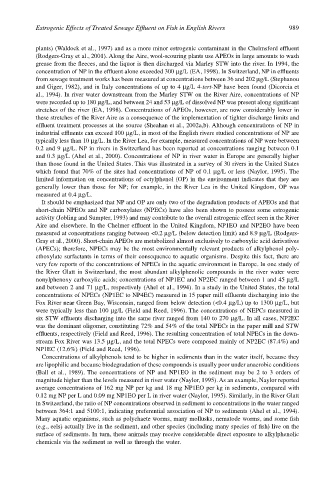Page 1009 - The Toxicology of Fishes
P. 1009
Estrogenic Effects of Treated Sewage Effluent on Fish in English Rivers 989
plants) (Waldock et al., 1997) and as a more minor estrogenic contaminant in the Chelmsford effluent
(Rodgers-Gray et al., 2001). Along the Aire, wool-scouring plants use APEOs in large amounts to wash
grease from the fleeces, and the liquor is then discharged via Marley STW into the river. In 1994, the
concentration of NP in the effluent alone exceeded 300 µg/L (EA, 1998). In Switzerland, NP in effluents
from sewage treatment works has been measured at concentrations between 36 and 202 µg/L (Stephanou
and Giger, 1982), and in Italy concentrations of up to 4 µg/L 4-tert-NP have been found (Dicorcia et
al., 1994). In river water downstream from the Marley STW on the River Aire, concentrations of NP
were recorded up to 180 µg/L, and between 24 and 53 µg/L of dissolved NP was present along significant
stretches of the river (EA, 1998). Concentrations of APEOs, however, are now considerably lower in
these stretches of the River Aire as a consequence of the implementation of tighter discharge limits and
effluent treatment processes at the source (Sheahan et al., 2002a,b). Although concentrations of NP in
industrial effluents can exceed 100 µg/L, in most of the English rivers studied concentrations of NP are
typically less than 10 µg/L. In the River Lea, for example, measured concentrations of NP were between
0.2 and 9 µg/L. NP in rivers in Switzerland has been reported at concentrations ranging between 0.1
and 0.3 µg/L (Ahel et al., 2000). Concentrations of NP in river water in Europe are generally higher
than those found in the United States. This was illustrated in a survey of 30 rivers in the United States
which found that 70% of the sites had concentrations of NP of 0.1 µg/L or less (Naylor, 1995). The
limited information on concentrations of octylphenol (OP) in the environment indicates that they are
generally lower than those for NP; for example, in the River Lea in the United Kingdom, OP was
measured at 0.4 µg/L.
It should be emphasized that NP and OP are only two of the degradation products of APEOs and that
short-chain NPEOs and NP carboxylates (NPECs) have also been shown to possess some estrogenic
activity (Jobling and Sumpter, 1993) and may contribute to the overall estrogenic effect seen in the River
Aire and elsewhere. In the Chelmer effluent in the United Kingdom, NP1EO and NP2EO have been
measured at concentrations ranging between <0.2 µg/L (below detection limit) and 8.9 µg/L (Rodgers-
Gray et al., 2000). Short-chain APEOs are metabolized almost exclusively to carboxylic acid derivatives
(APECs); therefore, NPECs may be the most environmentally relevant products of alkylphenol poly-
ethoxylate surfactants in terms of their consequence to aquatic organisms. Despite this fact, there are
very few reports of the concentrations of NPECs in the aquatic environment in Europe. In one study of
the River Glatt in Switzerland, the most abundant alkylphenolic compounds in the river water were
nonylphenoxy carboxylic acids; concentrations of NP1EC and NP2EC ranged between 1 and 45 µg/L
and between 2 and 71 µg/L, respectively (Ahel et al., 1994). In a study in the United States, the total
concentrations of NPECs (NP1EC to NP4EC) measured in 15 paper mill effluents discharging into the
Fox River near Green Bay, Wisconsin, ranged from below detection (<0.4 µg/L) up to 1300 µg/L, but
were typically less than 100 µg/L (Field and Reed, 1996). The concentrations of NEPCs measured in
six STW effluents discharging into the same river ranged from 140 to 270 µg/L. In all cases, NP2EC
was the dominant oligomer, constituting 72% and 54% of the total NPECs in the paper mill and STW
effluents, respectively (Field and Reed, 1996). The resulting concentration of total NPECs in the down-
stream Fox River was 13.5 µg/L, and the total NPECs were composed mainly of NP2EC (87.4%) and
NP1EC (12.6%) (Field and Reed, 1996).
Concentrations of alkylphenols tend to be higher in sediments than in the water itself, because they
are lipophilic and because biodegradation of these compounds is usually poor under anaerobic conditions
(Ball et al., 1989). The concentrations of NP and NP1EO in the sediment may be 2 to 3 orders of
magnitude higher than the levels measured in river water (Naylor, 1995). As an example, Naylor reported
average concentrations of 162 mg NP per kg and 18 mg NP1EO per kg in sediments, compared with
0.12 mg NP per L and 0.09 mg NP1EO per L in river water (Naylor, 1995). Similarly, in the River Glatt
in Switzerland, the ratio of NP concentrations observed in sediment to concentrations in the water ranged
between 364:1 and 5100:1, indicating preferential association of NP to sediments (Ahel et al., 1994).
Many aquatic organisms, such as polychaete worms, many mollusks, nematode worms, and some fish
(e.g., eels) actually live in the sediment, and other species (including many species of fish) live on the
surface of sediments. In turn, these animals may receive considerable direct exposure to alkylphenolic
chemicals via the sediment as well as through the water.

